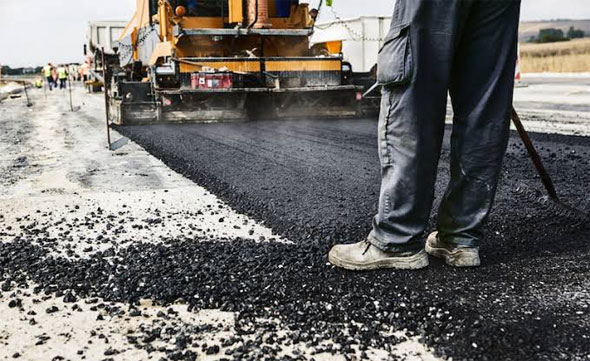Paving Construction
- Concrete Cost Estimator
- Concrete Continuous Footing
- Landscape Bidding and Estimating
- Construction Cost Estimating
- Concrete and steel cost estimation
- Construction Cost Estimate Breakdown
- Construction Estimating Worksheet
- Home Construction Cost Estimate
- Estimate Pricing Sheet
- Sheet for General Contractor
- Construction Cost Estimate
- Labor Materials Cost Estimator
- Masonry Estimating Sheet
- Sheet for Building Contractor
- Construction Schedule Bar chart
- General Cost Estimator Sheet
- General Construction Estimate
- Building and Road Estimating Sheet
- Detailed expense estimates
- Door and Window Takeoff Sheet
- General Construction Cost Estimating Sheet

Building the base or sub-base for pavement construction is mainly based on the type of base selected and the equipment obtainable. This article sheds light on some of the top base and sub-base layers for building pavement.
They are as follows: Cement Treated Base, Unstabilized Base, Asphalt Treated Base, Lean Concrete Base
1. Cement Treated Base for Pavement Construction: The method of placing a cement spread on the grade and being compacted by rollers are the major parts of a cement treated base. Given below, the most recognized methods for cement base construction for pavement :-
a. It must be marked, compacted and trimmed within 4 hours after the cement mixture is mixed. Based on the temperature and wind at the site, this working time is limited.
b. Minus or plus 1/2 inch of the design grade should be trimmed.
c. As soon as the base is finished, a frog spray of water or a bituminous curing agent should be applied to cure the surface.
d. Until the PCC sheet is added, it is advised to employ a bond breaker when the surface has to be trimmed and it is an unavoidable operation.
2. Unstabilized base for the construction of pavements: Building an unstable pavement base includes mixing, arranging, compacting and grading the material. While constructing the unstable pavement foundation, the following points should be kept in mind:
To achieve a homogeneous mixture, careful mixing must be done. Before and after compaction, the materials used must be adequately treated with water to retain the maximum level of moisture.
Also Read: How to estimate the material for a reinforcement concrete road
A minimum of 95 percent of normal proctor density in the field should be maintained in compliance with AASHTO T99. A minimum density of 98 percent should be provided for a pavement to bear large volumes.
As soon as the compaction is finished, the base should be calibrated to the grade of the design profile plus or minus 1/2 inches. The following uniformity in positioning, compacting and trimming will prevent the detachment of the aggregates.
Before paving, the unstabilized base should be moistened to keep away from dry base conditions.
3. Asphalt - Treated Base: The asphalt-treated base construction method is equivalent to a traditional asphalt surface. The key recommendations are:
A smooth asphalt treated base provides better functionality.
A rough surface leads to the friction of the PCC layer.
When applying the PCC coating, to minimize the surface temperature, the asphalt treated base must be sprayed with water or concrete healing compound or water lime solution. As the temperature of the surface will rise to 140 degrees celsius, the construction work should be performed at the night to avoid risk.
Asphalt-treated base often needs surface grade control. The finished asphalt-treated base surface must be 1/4th inch plus or minus the grade of the design profile.
4. Lean Concrete Base for Pavement Construction: Lean concrete construction of the foundation is carried out similarly to that of traditional concrete construction. The equipment used in traditional base building may be used by the contractor for a lean concrete base. It helps to spread the expense of mobilization to a larger extent of the job.
The construction of the base by lean concrete is performed similarly to that of conventional concrete. The equipment applied for conventional base construction can be employed for a lean concrete base by the contractor. This helps to distribute the mobilization cost to a greater scope of the work.

- Application of concrete calculator
- Roofing Calculator can streamline the roof estimating process
- House construction cost calculator
- Engineering column design excel spreadsheet
- Material Estimating Sheet with Excel
- Materials List and Cost Estimate Worksheet
- Concrete Slab Estimating Calculator Sheet
- Common types of foundations for buildings
- Online calculation of construction materials
- Estimating with Excel for the Small Contractor
- Concrete Beam Design Spreadsheet
- Virtual Construction Management app for construction
- Autodesk’s Project Skyscraper
- Reed Construction’s Reed Insight
- Manage your construction project documentation
- Costimator, the popular cost estimating software
- On Center Software for construction professionals
- Free Construction Estimating Software
- Plumbing Calc Pro
- Cost Estimate Worksheet
- HVAC Piping Quantity Takeoff Worksheet
- Construction Estimating Software Sheet
- Estimate Cost Templates
- Construction Punch List
- Construction cost estimating template consisting estimating basic
- Gantt Chart Template for Excel
- Download Civil Engineering Spreadsheets with Verification
- The Building Advisor Estimating and Budgeting Worksheet
- Spreadsheet for design of concrete bridge
- Construction Estimating Software Free








